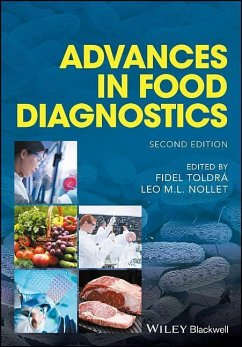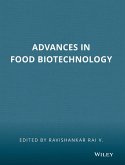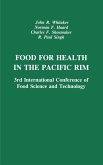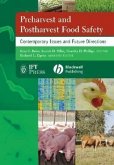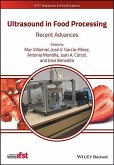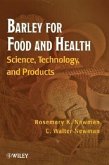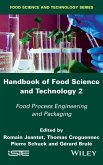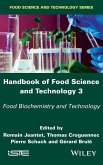Advances in Food Diagnostics
Herausgeber: Toldrá, Fidel; Nollet, Leo M L
Advances in Food Diagnostics
Herausgeber: Toldrá, Fidel; Nollet, Leo M L
- Gebundenes Buch
- Merkliste
- Auf die Merkliste
- Bewerten Bewerten
- Teilen
- Produkt teilen
- Produkterinnerung
- Produkterinnerung
Featuring seven entirely new chapters, the second edition of this critically acclaimed guide has been extensively revised and updated. Once again delivering food professionals the latest advances in food diagnostics and analysis, the book approaches the topic in several different ways: reviewing novel technologies to evaluate fresh products; describing and analysing in depth specific modern diagnostics; providing analyses of data processing; and discussing global marketing, with insights into future trends. Written by an international team of experts, this volume not only covers most…mehr
Andere Kunden interessierten sich auch für
![Advances in Food Biotechnology Advances in Food Biotechnology]() Advances in Food Biotechnology306,99 €
Advances in Food Biotechnology306,99 €![Food for Health in the Pacific Rim Food for Health in the Pacific Rim]() Food for Health in the Pacific Rim191,99 €
Food for Health in the Pacific Rim191,99 €![Preharvest and Postharvest Food Safety Preharvest and Postharvest Food Safety]() BeierPreharvest and Postharvest Food Safety329,99 €
BeierPreharvest and Postharvest Food Safety329,99 €![Ultrasound in Food Processing Ultrasound in Food Processing]() Ultrasound in Food Processing262,99 €
Ultrasound in Food Processing262,99 €![Barley for Food and Health Barley for Food and Health]() Rosemary K NewmanBarley for Food and Health158,99 €
Rosemary K NewmanBarley for Food and Health158,99 €![Handbook of Food Science and Technology 2 Handbook of Food Science and Technology 2]() Romain JeantetHandbook of Food Science and Technology 2192,99 €
Romain JeantetHandbook of Food Science and Technology 2192,99 €![Handbook of Food Science and Technology 3 Handbook of Food Science and Technology 3]() Handbook of Food Science and Technology 3192,99 €
Handbook of Food Science and Technology 3192,99 €-
-
-
Featuring seven entirely new chapters, the second edition of this critically acclaimed guide has been extensively revised and updated. Once again delivering food professionals the latest advances in food diagnostics and analysis, the book approaches the topic in several different ways: reviewing novel technologies to evaluate fresh products; describing and analysing in depth specific modern diagnostics; providing analyses of data processing; and discussing global marketing, with insights into future trends. Written by an international team of experts, this volume not only covers most conventional lab-based analytical methods, but also focuses on leading-edge technologies which are being or are about to be introduced. Advances in Food Diagnostics, Second Edition: * Covers ultrasound, RMN, chromatography, electronic noses, immunology, GMO detection and microbiological and molecular methodologies for rapid detection of pathogens * Explores the principles and applications of immunodiagnostics in food safety and the use of molecular biology to detect and characterize foodborne pathogens * Includes DNA-based and protein-based technologies to detect and identify genetically-modified food or food components * Focuses on the translation of diagnostics tests from bench to the market in order to illustrate the benefits to the food industry * Provides an overview of the business end of food diagnostics; identifying the markets, delineating the sellers and the buyers, comparing current technology with traditional methods, certifying operations and procedures, and analysing diagnostic devices within the food and related industries This is an indispensable resource for food scientists, food quality analysts, food microbiologists and food safety professionals. It also belongs on the reference shelves of labs conducting food diagnostics for the analysis of the sensory, quality and safety aspects of food.
Hinweis: Dieser Artikel kann nur an eine deutsche Lieferadresse ausgeliefert werden.
Hinweis: Dieser Artikel kann nur an eine deutsche Lieferadresse ausgeliefert werden.
Produktdetails
- Produktdetails
- Verlag: Wiley
- 2nd edition
- Seitenzahl: 528
- Erscheinungstermin: 5. September 2017
- Englisch
- Abmessung: 246mm x 175mm x 28mm
- Gewicht: 1270g
- ISBN-13: 9781119105886
- ISBN-10: 1119105889
- Artikelnr.: 47547963
- Herstellerkennzeichnung
- Produktsicherheitsverantwortliche/r
- Europaallee 1
- 36244 Bad Hersfeld
- gpsr@libri.de
- Verlag: Wiley
- 2nd edition
- Seitenzahl: 528
- Erscheinungstermin: 5. September 2017
- Englisch
- Abmessung: 246mm x 175mm x 28mm
- Gewicht: 1270g
- ISBN-13: 9781119105886
- ISBN-10: 1119105889
- Artikelnr.: 47547963
- Herstellerkennzeichnung
- Produktsicherheitsverantwortliche/r
- Europaallee 1
- 36244 Bad Hersfeld
- gpsr@libri.de
FIDEL TOLDRÁ, PhD, is a Research Professor at the Department of Food Science, Instituto de Agroquímica y Tecnología de Alimentos (CSIC), Spain. He serves as European Editor of Trends in Food Science and Technology. His research interests are devoted to food biochemistry and analysis, especially focused on foods of animal origin. LEO M.L. NOLLET, PhD, is a retired professor of University College Ghent, Belgium. His research interests are in the domain of food analysis, chromatography, and analysis of environmental parameters.
List of Contributors xvii Preface xxiii 1 Assuring Safety and Quality along the Food Chain 1 Gerhard Schiefer 1.1 Quality and safety: issues 1 1.2 Tracking and tracing through chains and networks 2 1.3 Food safety - the baseline 3 1.4 Food quality - delivery concepts 4 1.5 Quality programs - steps towards sector quality agreements 5 1.6 The information challenge 7 1.7 Conclusion 10 References 11 2 Methodologies for Improved Quality Control Assessment of Food Products 13 Manuel A. Coimbra, Silvia M. Rocha, Catia Martins and Antonio S. Barros 2.1 Introduction 13 2.2 Use of FT-IR spectroscopy as a tool for the analysis of polysaccharide food additives 14 2.3 Use of outer product (OP) and orthogonal signal correction (OSC) PLS1 regressions in FT-IR spectroscopy for quantification purposes of complex food sample matrices 23 2.4 Screening and distinction of coffee brews based on headspace - solid phase microextraction combined with gas chromatography in tandem with principal component analysis (HS-SPME/GC-PCA) 33 2.5 Comprehensive two-dimensional gas chromatography (GC × GC) combined with time-of-flight mass spectrometry (ToFMS) as a powerful tool for food products analysis 38 2.6 Study of cork (from Quercus suber L.) - wine model interactions based on voltammetric multivariate analysis 44 2.7 Concluding remarks 52 References 52 3 Developments in Electronic Noses for Quality and Safety Control 63 John Bosco Balaguru Rayappan, Arockia Jayalatha Kulandaisamy, Madeshwari Ezhilan, Parthasarathy Srinivasan and Ganesh Kumar Mani 3.1 Introduction 63 3.2 Overview of classical techniques for food quality testing 65 3.3 Electronic Nose 75 3.4 Instrumentation of eNose (Loutfi et al., 2015) 77 3.5 Recent developments in electronic nose applications for food quality 79 3.6 Conclusion 85 References 85 4 Proteomics and Peptidomics as Tools for Detection of Food Contamination by Bacteria 97 Dina Reetar, Tamara Martinovi
, Sandra Kraljevi
Paveli
, Uro Andjelkovi
and Djuro Josi
4.1 Introduction 97 4.2 Bacteria as food-borne pathogens 98 4.3 Gram-positive bacteria 101 4.4 Gram-negative bacteria 106 4.5 Bacterial toxins 110 4.6 Detection of bacterial contamination in food 114 4.7 Analysis of bacterial toxins 121 4.8 Conclusions 126 4.9 Acknowledgements 127 References 127 5 Metabolomics in Assessment of Nutritional Status 139 Kati Hanhineva 5.1 Introduction 139 5.2 Usability of metabolomics in nutrition sciences 139 5.3 The metabolite complement in human studies 140 5.4 Metabolomics within the analysis of relationship between diet and health 141 5.5 Individual differences in metabolic and nutritional phenotype 142 5.6 Assessment of nutritional status, example studies 143 References 148 6 Rapid Microbiological Methods in Food Diagnostics 153 Catherine M. Logue and Chantal W. Nde 6.1 Introduction 153 6.2 Quantitative vs qualitative 154 6.3 Culture dependent vs independent 154 6.4 Automation and multi-pathogen detection 155 6.5 Separation and concentration 156 6.6 Rapid methods that are currently in the market 157 6.7 Conclusion 173 References 173 7 Molecular Technologies for the Detection and Characterisation of Food-Borne Pathogens 187 Geraldine Duffy 7.1 Introduction 187 7.2 Hybridisation-based methods 188 7.3 Nucleic acid amplification methods 190 7.4 Molecular characterisation methods 195 7.5 Conclusion 198 References 198 8 DNA-based Detection of GM Ingredients 205 Patrick Guertler, Alexandra Hahn, Ulrich Busch and Karl-Heinz Engel 8.1 Introduction 205 8.2 Analysis of GMO 205 8.3 Quantification of GMOs 215 8.4 Validation 217 8.5 Challenges in GMO detection 218 8.6 Outlook 221 References 222 9 Enzyme-based Sensors 231 Anastasios Economou, Stephanos K. Karapetis, Georgia-Paraskevi Nikoleli, Dimitrios P. Nikolelis, Spyridoula Bratakou and Theodoros H. Varzakas 9.1 Introduction to enzymatic biosensors 231 9.2 Types of transducers 235 9.3 Enzymatic biosensors and the food industry 238 9.4 Biosensors for the analysis of main food components 239 9.5 Biosensors for contaminants 244 9.6 Food freshness indicators, antinutrients and additives 246 9.7 Future perspectives 247 References 248 10 Immunology-based Biosensors 251 Theodoros H. Varzakas, Georgia-Paraskevi Nikoleli and Dimitrios P. Nikolelis 10.1 Introduction 251 10.2 Antibodies and biosensors 251 10.3 Immunoassays for detection of microorganisms 255 10.4 Immunosensors and cancer biomarkers-immunoarrays 259 References 261 11 Graphene and Carbon Nanotube-Based Biosensors for Food Analysis 269 Stephanos K. Karapetis, Spyridoula M. Bratakou, Georgia-Paraskevi Nikoleli, Christina G. Siontorou, Dimitrios P. Nikolelis and Nikolaos Tzamtzis 11.1 Introduction 269 11.2 Biosensing devices based on graphene and CNTs and their applications in food analysis 270 11.3 Future trends and prospects 274 12 Nanoparticles-Based Sensors 279 Luis G. Dias, Antonio M. Peres and Alfredo Teixeira 12.1 Introduction 279 12.2 Nanoparticles for sensor technology 280 12.3 Nanoparticles-based sensors: applications 286 12.4 Conclusions and future trends 298 References 299 13 New Technologies for Nanoparticles Detection in Foods 305 G. Castillo, Z. Garaiova and T. Hianik 13.1 Introduction 305 13.2 Nanoparticle properties and applications in food industry 306 13.3 Toxicity of food-related nanoparticles 317 13.4 Methods of nanoparticle detection in food 321 13.5 Conclusion 330 13.6 Acknowledgments 330 References 330 14 Rapid Liquid Chromatographic Techniques for Detection of Key (Bio)chemical Markers 343 M
Concepcion Aristoy, Milagro Reig and Fidel Toldra 14.1 Introduction 343 14.2 The fundamentals of liquid chromatography 344 14.3 Advances in modern HPLC 346 14.4 Analysis of biochemical markers: applications for nutritional quality 347 14.5 Analysis of biochemical markers: applications for food quality 354 14.6 Analysis of biochemical markers: applications for the detection of food adulterations 356 14.7 Analysis of biochemical markers: applications for food safety 357 References 362 15 Olfactometry Detection of Aroma Compounds 379 Monica Flores and Sara Corral 15.1 Introduction 379 15.2 Extraction of volatile compounds from foods for GC-olfactometry analysis (GC-O) 380 15.3 Olfactometry techniques 382 15.4 Applications of GC-O in food industry 389 15.5 Conclusions 395 15.6 Acknowledgements 396 References 396 16 Data Handling 401 Riccardo Leardi 16.1 Introduction 401 16.2 Data collection 402 16.3 Data display 403 16.4 Process monitoring and quality control 417 16.5 Three-way PCA 417 16.6 Classification 420 16.7 Modelling 423 16.8 Calibration 424 16.9 Variable selection 426 16.10 Conclusion: future trends and the advantages and disadvantages of chemometrics 428 References 429 Suggested Books 430 17 Automated Sampling Procedures 431 Semih Otles and Canan Kartal 17.1 Introduction 431 17.2 Extraction techniques for sample preparation 432 References 453 18 The Market for Diagnostic Devices in the Food Industry 465 Mark Buecking, Hans Hoogland and Huub Lelieveld 18.1 Introduction 465 18.2 Food diagnostics 461 18.3 Product composition 466 18.4 Product structure 471 18.5 Influence of processing on product composition 472 18.6 Processing parameters 473 18.7 Packaging parameters 476 18.8 Conclusion 477 References 478 Index 479
, Sandra Kraljevi
Paveli
, Uro Andjelkovi
and Djuro Josi
4.1 Introduction 97 4.2 Bacteria as food-borne pathogens 98 4.3 Gram-positive bacteria 101 4.4 Gram-negative bacteria 106 4.5 Bacterial toxins 110 4.6 Detection of bacterial contamination in food 114 4.7 Analysis of bacterial toxins 121 4.8 Conclusions 126 4.9 Acknowledgements 127 References 127 5 Metabolomics in Assessment of Nutritional Status 139 Kati Hanhineva 5.1 Introduction 139 5.2 Usability of metabolomics in nutrition sciences 139 5.3 The metabolite complement in human studies 140 5.4 Metabolomics within the analysis of relationship between diet and health 141 5.5 Individual differences in metabolic and nutritional phenotype 142 5.6 Assessment of nutritional status, example studies 143 References 148 6 Rapid Microbiological Methods in Food Diagnostics 153 Catherine M. Logue and Chantal W. Nde 6.1 Introduction 153 6.2 Quantitative vs qualitative 154 6.3 Culture dependent vs independent 154 6.4 Automation and multi-pathogen detection 155 6.5 Separation and concentration 156 6.6 Rapid methods that are currently in the market 157 6.7 Conclusion 173 References 173 7 Molecular Technologies for the Detection and Characterisation of Food-Borne Pathogens 187 Geraldine Duffy 7.1 Introduction 187 7.2 Hybridisation-based methods 188 7.3 Nucleic acid amplification methods 190 7.4 Molecular characterisation methods 195 7.5 Conclusion 198 References 198 8 DNA-based Detection of GM Ingredients 205 Patrick Guertler, Alexandra Hahn, Ulrich Busch and Karl-Heinz Engel 8.1 Introduction 205 8.2 Analysis of GMO 205 8.3 Quantification of GMOs 215 8.4 Validation 217 8.5 Challenges in GMO detection 218 8.6 Outlook 221 References 222 9 Enzyme-based Sensors 231 Anastasios Economou, Stephanos K. Karapetis, Georgia-Paraskevi Nikoleli, Dimitrios P. Nikolelis, Spyridoula Bratakou and Theodoros H. Varzakas 9.1 Introduction to enzymatic biosensors 231 9.2 Types of transducers 235 9.3 Enzymatic biosensors and the food industry 238 9.4 Biosensors for the analysis of main food components 239 9.5 Biosensors for contaminants 244 9.6 Food freshness indicators, antinutrients and additives 246 9.7 Future perspectives 247 References 248 10 Immunology-based Biosensors 251 Theodoros H. Varzakas, Georgia-Paraskevi Nikoleli and Dimitrios P. Nikolelis 10.1 Introduction 251 10.2 Antibodies and biosensors 251 10.3 Immunoassays for detection of microorganisms 255 10.4 Immunosensors and cancer biomarkers-immunoarrays 259 References 261 11 Graphene and Carbon Nanotube-Based Biosensors for Food Analysis 269 Stephanos K. Karapetis, Spyridoula M. Bratakou, Georgia-Paraskevi Nikoleli, Christina G. Siontorou, Dimitrios P. Nikolelis and Nikolaos Tzamtzis 11.1 Introduction 269 11.2 Biosensing devices based on graphene and CNTs and their applications in food analysis 270 11.3 Future trends and prospects 274 12 Nanoparticles-Based Sensors 279 Luis G. Dias, Antonio M. Peres and Alfredo Teixeira 12.1 Introduction 279 12.2 Nanoparticles for sensor technology 280 12.3 Nanoparticles-based sensors: applications 286 12.4 Conclusions and future trends 298 References 299 13 New Technologies for Nanoparticles Detection in Foods 305 G. Castillo, Z. Garaiova and T. Hianik 13.1 Introduction 305 13.2 Nanoparticle properties and applications in food industry 306 13.3 Toxicity of food-related nanoparticles 317 13.4 Methods of nanoparticle detection in food 321 13.5 Conclusion 330 13.6 Acknowledgments 330 References 330 14 Rapid Liquid Chromatographic Techniques for Detection of Key (Bio)chemical Markers 343 M
Concepcion Aristoy, Milagro Reig and Fidel Toldra 14.1 Introduction 343 14.2 The fundamentals of liquid chromatography 344 14.3 Advances in modern HPLC 346 14.4 Analysis of biochemical markers: applications for nutritional quality 347 14.5 Analysis of biochemical markers: applications for food quality 354 14.6 Analysis of biochemical markers: applications for the detection of food adulterations 356 14.7 Analysis of biochemical markers: applications for food safety 357 References 362 15 Olfactometry Detection of Aroma Compounds 379 Monica Flores and Sara Corral 15.1 Introduction 379 15.2 Extraction of volatile compounds from foods for GC-olfactometry analysis (GC-O) 380 15.3 Olfactometry techniques 382 15.4 Applications of GC-O in food industry 389 15.5 Conclusions 395 15.6 Acknowledgements 396 References 396 16 Data Handling 401 Riccardo Leardi 16.1 Introduction 401 16.2 Data collection 402 16.3 Data display 403 16.4 Process monitoring and quality control 417 16.5 Three-way PCA 417 16.6 Classification 420 16.7 Modelling 423 16.8 Calibration 424 16.9 Variable selection 426 16.10 Conclusion: future trends and the advantages and disadvantages of chemometrics 428 References 429 Suggested Books 430 17 Automated Sampling Procedures 431 Semih Otles and Canan Kartal 17.1 Introduction 431 17.2 Extraction techniques for sample preparation 432 References 453 18 The Market for Diagnostic Devices in the Food Industry 465 Mark Buecking, Hans Hoogland and Huub Lelieveld 18.1 Introduction 465 18.2 Food diagnostics 461 18.3 Product composition 466 18.4 Product structure 471 18.5 Influence of processing on product composition 472 18.6 Processing parameters 473 18.7 Packaging parameters 476 18.8 Conclusion 477 References 478 Index 479
List of Contributors xvii Preface xxiii 1 Assuring Safety and Quality along the Food Chain 1 Gerhard Schiefer 1.1 Quality and safety: issues 1 1.2 Tracking and tracing through chains and networks 2 1.3 Food safety - the baseline 3 1.4 Food quality - delivery concepts 4 1.5 Quality programs - steps towards sector quality agreements 5 1.6 The information challenge 7 1.7 Conclusion 10 References 11 2 Methodologies for Improved Quality Control Assessment of Food Products 13 Manuel A. Coimbra, Silvia M. Rocha, Catia Martins and Antonio S. Barros 2.1 Introduction 13 2.2 Use of FT-IR spectroscopy as a tool for the analysis of polysaccharide food additives 14 2.3 Use of outer product (OP) and orthogonal signal correction (OSC) PLS1 regressions in FT-IR spectroscopy for quantification purposes of complex food sample matrices 23 2.4 Screening and distinction of coffee brews based on headspace - solid phase microextraction combined with gas chromatography in tandem with principal component analysis (HS-SPME/GC-PCA) 33 2.5 Comprehensive two-dimensional gas chromatography (GC × GC) combined with time-of-flight mass spectrometry (ToFMS) as a powerful tool for food products analysis 38 2.6 Study of cork (from Quercus suber L.) - wine model interactions based on voltammetric multivariate analysis 44 2.7 Concluding remarks 52 References 52 3 Developments in Electronic Noses for Quality and Safety Control 63 John Bosco Balaguru Rayappan, Arockia Jayalatha Kulandaisamy, Madeshwari Ezhilan, Parthasarathy Srinivasan and Ganesh Kumar Mani 3.1 Introduction 63 3.2 Overview of classical techniques for food quality testing 65 3.3 Electronic Nose 75 3.4 Instrumentation of eNose (Loutfi et al., 2015) 77 3.5 Recent developments in electronic nose applications for food quality 79 3.6 Conclusion 85 References 85 4 Proteomics and Peptidomics as Tools for Detection of Food Contamination by Bacteria 97 Dina Reetar, Tamara Martinovi
, Sandra Kraljevi
Paveli
, Uro Andjelkovi
and Djuro Josi
4.1 Introduction 97 4.2 Bacteria as food-borne pathogens 98 4.3 Gram-positive bacteria 101 4.4 Gram-negative bacteria 106 4.5 Bacterial toxins 110 4.6 Detection of bacterial contamination in food 114 4.7 Analysis of bacterial toxins 121 4.8 Conclusions 126 4.9 Acknowledgements 127 References 127 5 Metabolomics in Assessment of Nutritional Status 139 Kati Hanhineva 5.1 Introduction 139 5.2 Usability of metabolomics in nutrition sciences 139 5.3 The metabolite complement in human studies 140 5.4 Metabolomics within the analysis of relationship between diet and health 141 5.5 Individual differences in metabolic and nutritional phenotype 142 5.6 Assessment of nutritional status, example studies 143 References 148 6 Rapid Microbiological Methods in Food Diagnostics 153 Catherine M. Logue and Chantal W. Nde 6.1 Introduction 153 6.2 Quantitative vs qualitative 154 6.3 Culture dependent vs independent 154 6.4 Automation and multi-pathogen detection 155 6.5 Separation and concentration 156 6.6 Rapid methods that are currently in the market 157 6.7 Conclusion 173 References 173 7 Molecular Technologies for the Detection and Characterisation of Food-Borne Pathogens 187 Geraldine Duffy 7.1 Introduction 187 7.2 Hybridisation-based methods 188 7.3 Nucleic acid amplification methods 190 7.4 Molecular characterisation methods 195 7.5 Conclusion 198 References 198 8 DNA-based Detection of GM Ingredients 205 Patrick Guertler, Alexandra Hahn, Ulrich Busch and Karl-Heinz Engel 8.1 Introduction 205 8.2 Analysis of GMO 205 8.3 Quantification of GMOs 215 8.4 Validation 217 8.5 Challenges in GMO detection 218 8.6 Outlook 221 References 222 9 Enzyme-based Sensors 231 Anastasios Economou, Stephanos K. Karapetis, Georgia-Paraskevi Nikoleli, Dimitrios P. Nikolelis, Spyridoula Bratakou and Theodoros H. Varzakas 9.1 Introduction to enzymatic biosensors 231 9.2 Types of transducers 235 9.3 Enzymatic biosensors and the food industry 238 9.4 Biosensors for the analysis of main food components 239 9.5 Biosensors for contaminants 244 9.6 Food freshness indicators, antinutrients and additives 246 9.7 Future perspectives 247 References 248 10 Immunology-based Biosensors 251 Theodoros H. Varzakas, Georgia-Paraskevi Nikoleli and Dimitrios P. Nikolelis 10.1 Introduction 251 10.2 Antibodies and biosensors 251 10.3 Immunoassays for detection of microorganisms 255 10.4 Immunosensors and cancer biomarkers-immunoarrays 259 References 261 11 Graphene and Carbon Nanotube-Based Biosensors for Food Analysis 269 Stephanos K. Karapetis, Spyridoula M. Bratakou, Georgia-Paraskevi Nikoleli, Christina G. Siontorou, Dimitrios P. Nikolelis and Nikolaos Tzamtzis 11.1 Introduction 269 11.2 Biosensing devices based on graphene and CNTs and their applications in food analysis 270 11.3 Future trends and prospects 274 12 Nanoparticles-Based Sensors 279 Luis G. Dias, Antonio M. Peres and Alfredo Teixeira 12.1 Introduction 279 12.2 Nanoparticles for sensor technology 280 12.3 Nanoparticles-based sensors: applications 286 12.4 Conclusions and future trends 298 References 299 13 New Technologies for Nanoparticles Detection in Foods 305 G. Castillo, Z. Garaiova and T. Hianik 13.1 Introduction 305 13.2 Nanoparticle properties and applications in food industry 306 13.3 Toxicity of food-related nanoparticles 317 13.4 Methods of nanoparticle detection in food 321 13.5 Conclusion 330 13.6 Acknowledgments 330 References 330 14 Rapid Liquid Chromatographic Techniques for Detection of Key (Bio)chemical Markers 343 M
Concepcion Aristoy, Milagro Reig and Fidel Toldra 14.1 Introduction 343 14.2 The fundamentals of liquid chromatography 344 14.3 Advances in modern HPLC 346 14.4 Analysis of biochemical markers: applications for nutritional quality 347 14.5 Analysis of biochemical markers: applications for food quality 354 14.6 Analysis of biochemical markers: applications for the detection of food adulterations 356 14.7 Analysis of biochemical markers: applications for food safety 357 References 362 15 Olfactometry Detection of Aroma Compounds 379 Monica Flores and Sara Corral 15.1 Introduction 379 15.2 Extraction of volatile compounds from foods for GC-olfactometry analysis (GC-O) 380 15.3 Olfactometry techniques 382 15.4 Applications of GC-O in food industry 389 15.5 Conclusions 395 15.6 Acknowledgements 396 References 396 16 Data Handling 401 Riccardo Leardi 16.1 Introduction 401 16.2 Data collection 402 16.3 Data display 403 16.4 Process monitoring and quality control 417 16.5 Three-way PCA 417 16.6 Classification 420 16.7 Modelling 423 16.8 Calibration 424 16.9 Variable selection 426 16.10 Conclusion: future trends and the advantages and disadvantages of chemometrics 428 References 429 Suggested Books 430 17 Automated Sampling Procedures 431 Semih Otles and Canan Kartal 17.1 Introduction 431 17.2 Extraction techniques for sample preparation 432 References 453 18 The Market for Diagnostic Devices in the Food Industry 465 Mark Buecking, Hans Hoogland and Huub Lelieveld 18.1 Introduction 465 18.2 Food diagnostics 461 18.3 Product composition 466 18.4 Product structure 471 18.5 Influence of processing on product composition 472 18.6 Processing parameters 473 18.7 Packaging parameters 476 18.8 Conclusion 477 References 478 Index 479
, Sandra Kraljevi
Paveli
, Uro Andjelkovi
and Djuro Josi
4.1 Introduction 97 4.2 Bacteria as food-borne pathogens 98 4.3 Gram-positive bacteria 101 4.4 Gram-negative bacteria 106 4.5 Bacterial toxins 110 4.6 Detection of bacterial contamination in food 114 4.7 Analysis of bacterial toxins 121 4.8 Conclusions 126 4.9 Acknowledgements 127 References 127 5 Metabolomics in Assessment of Nutritional Status 139 Kati Hanhineva 5.1 Introduction 139 5.2 Usability of metabolomics in nutrition sciences 139 5.3 The metabolite complement in human studies 140 5.4 Metabolomics within the analysis of relationship between diet and health 141 5.5 Individual differences in metabolic and nutritional phenotype 142 5.6 Assessment of nutritional status, example studies 143 References 148 6 Rapid Microbiological Methods in Food Diagnostics 153 Catherine M. Logue and Chantal W. Nde 6.1 Introduction 153 6.2 Quantitative vs qualitative 154 6.3 Culture dependent vs independent 154 6.4 Automation and multi-pathogen detection 155 6.5 Separation and concentration 156 6.6 Rapid methods that are currently in the market 157 6.7 Conclusion 173 References 173 7 Molecular Technologies for the Detection and Characterisation of Food-Borne Pathogens 187 Geraldine Duffy 7.1 Introduction 187 7.2 Hybridisation-based methods 188 7.3 Nucleic acid amplification methods 190 7.4 Molecular characterisation methods 195 7.5 Conclusion 198 References 198 8 DNA-based Detection of GM Ingredients 205 Patrick Guertler, Alexandra Hahn, Ulrich Busch and Karl-Heinz Engel 8.1 Introduction 205 8.2 Analysis of GMO 205 8.3 Quantification of GMOs 215 8.4 Validation 217 8.5 Challenges in GMO detection 218 8.6 Outlook 221 References 222 9 Enzyme-based Sensors 231 Anastasios Economou, Stephanos K. Karapetis, Georgia-Paraskevi Nikoleli, Dimitrios P. Nikolelis, Spyridoula Bratakou and Theodoros H. Varzakas 9.1 Introduction to enzymatic biosensors 231 9.2 Types of transducers 235 9.3 Enzymatic biosensors and the food industry 238 9.4 Biosensors for the analysis of main food components 239 9.5 Biosensors for contaminants 244 9.6 Food freshness indicators, antinutrients and additives 246 9.7 Future perspectives 247 References 248 10 Immunology-based Biosensors 251 Theodoros H. Varzakas, Georgia-Paraskevi Nikoleli and Dimitrios P. Nikolelis 10.1 Introduction 251 10.2 Antibodies and biosensors 251 10.3 Immunoassays for detection of microorganisms 255 10.4 Immunosensors and cancer biomarkers-immunoarrays 259 References 261 11 Graphene and Carbon Nanotube-Based Biosensors for Food Analysis 269 Stephanos K. Karapetis, Spyridoula M. Bratakou, Georgia-Paraskevi Nikoleli, Christina G. Siontorou, Dimitrios P. Nikolelis and Nikolaos Tzamtzis 11.1 Introduction 269 11.2 Biosensing devices based on graphene and CNTs and their applications in food analysis 270 11.3 Future trends and prospects 274 12 Nanoparticles-Based Sensors 279 Luis G. Dias, Antonio M. Peres and Alfredo Teixeira 12.1 Introduction 279 12.2 Nanoparticles for sensor technology 280 12.3 Nanoparticles-based sensors: applications 286 12.4 Conclusions and future trends 298 References 299 13 New Technologies for Nanoparticles Detection in Foods 305 G. Castillo, Z. Garaiova and T. Hianik 13.1 Introduction 305 13.2 Nanoparticle properties and applications in food industry 306 13.3 Toxicity of food-related nanoparticles 317 13.4 Methods of nanoparticle detection in food 321 13.5 Conclusion 330 13.6 Acknowledgments 330 References 330 14 Rapid Liquid Chromatographic Techniques for Detection of Key (Bio)chemical Markers 343 M
Concepcion Aristoy, Milagro Reig and Fidel Toldra 14.1 Introduction 343 14.2 The fundamentals of liquid chromatography 344 14.3 Advances in modern HPLC 346 14.4 Analysis of biochemical markers: applications for nutritional quality 347 14.5 Analysis of biochemical markers: applications for food quality 354 14.6 Analysis of biochemical markers: applications for the detection of food adulterations 356 14.7 Analysis of biochemical markers: applications for food safety 357 References 362 15 Olfactometry Detection of Aroma Compounds 379 Monica Flores and Sara Corral 15.1 Introduction 379 15.2 Extraction of volatile compounds from foods for GC-olfactometry analysis (GC-O) 380 15.3 Olfactometry techniques 382 15.4 Applications of GC-O in food industry 389 15.5 Conclusions 395 15.6 Acknowledgements 396 References 396 16 Data Handling 401 Riccardo Leardi 16.1 Introduction 401 16.2 Data collection 402 16.3 Data display 403 16.4 Process monitoring and quality control 417 16.5 Three-way PCA 417 16.6 Classification 420 16.7 Modelling 423 16.8 Calibration 424 16.9 Variable selection 426 16.10 Conclusion: future trends and the advantages and disadvantages of chemometrics 428 References 429 Suggested Books 430 17 Automated Sampling Procedures 431 Semih Otles and Canan Kartal 17.1 Introduction 431 17.2 Extraction techniques for sample preparation 432 References 453 18 The Market for Diagnostic Devices in the Food Industry 465 Mark Buecking, Hans Hoogland and Huub Lelieveld 18.1 Introduction 465 18.2 Food diagnostics 461 18.3 Product composition 466 18.4 Product structure 471 18.5 Influence of processing on product composition 472 18.6 Processing parameters 473 18.7 Packaging parameters 476 18.8 Conclusion 477 References 478 Index 479

